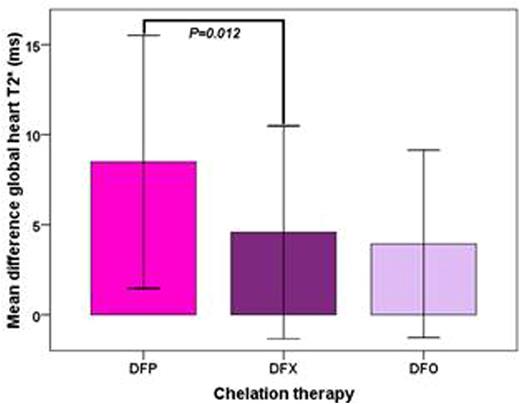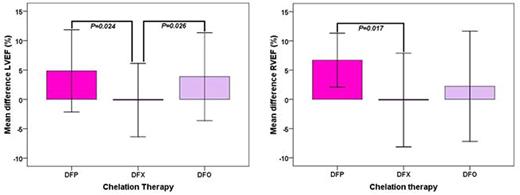Abstract
Background: No prospective data are available about the efficacy of deferasirox versus deferiprone and desferrioxamine in monotherapy. Our study aimed to prospectively assess the efficacy of deferasirox versus deferiprone and desferrioxamine in monotherapy in a large cohort of thalassemia major (TM) patients by quantitative Magnetic Resonance (MR).
Methods: Among the 2551 TM patients enrolled in the MIOT (Myocardial Iron Overload in Thalassemia) network we selected those with an MR follow up study at 18±3 months who had been received one chelator alone between the 2 MR scans. We identified three groups of patients: 235 treated with DFX, 142 with DFP and 162 with DFO. Iron overload was measured by T2* multiecho technique. Liver T2* values were converted into liver iron concentration (LIC) values. Biventricular function parameters were quantitatively evaluated by cine images.
Results: Excellent/good levels of compliance were similar in the DFX (98.7%) vs DFP (96.3%) and DFO (97.5%) groups.
Among the patients with myocardial iron overload at baseline, in all three groups there was a significant improvement in the global heart T2* value (DFX: +4.58±5.91ms P<0.0001, DFP: 8.53±6.97ms P<0.0001 and DFO: +3.93±5.21 ms P<0.0001) and a reduction in the number of pathological segments (DFX: -4.49±4.55 P<0.0001, DFP: -8.08±5.5.84 ms P=0.001 and DFO: -3.65±3.81 ms P<0.0001). In DFP and in DFO groups there was a significant improvement in left ventricular ejection function (LVEF) (+4.86±6.99% P=0.044 and +3.87±7.48% P=0.004, respectively). Only in the DFP group there was a significant improvement in right ventricular ejection function (RVEF) (6.69±4.61% P=0.001). The improvement in the global heart T2* was significantly lower in the DFX versus the DFP group , but it was not significantly different in the DFX versus the DFO group (Figure 1). The improvement in the LVEF was significantly higher in both DFP and DFO groups than in the DFX group while the improvement in the RVEF was significantly higher in the DFP than in DFX group (Figure 2).
Among the patients with hepatic iron at baseline (LIC≥3mg/g dw) the changes were not significantly different in DFX versus the other groups.
Conclusions: Prospectively in a large clinical setting of TM patients, DFX monotherapy was significantly less effective than DFP in improving myocardial siderosis and biventricular function and it was significantly less effective than DFO in improving the LVEF.
Pepe:Chiesi Farmaceutici and ApoPharma Inc.: Other: Alessia Pepe is the PI of the MIOT project, that receives no profit support from Chiesi Farmaceutici S.p.A. and ApoPharma Inc..
Author notes
Asterisk with author names denotes non-ASH members.



This feature is available to Subscribers Only
Sign In or Create an Account Close Modal